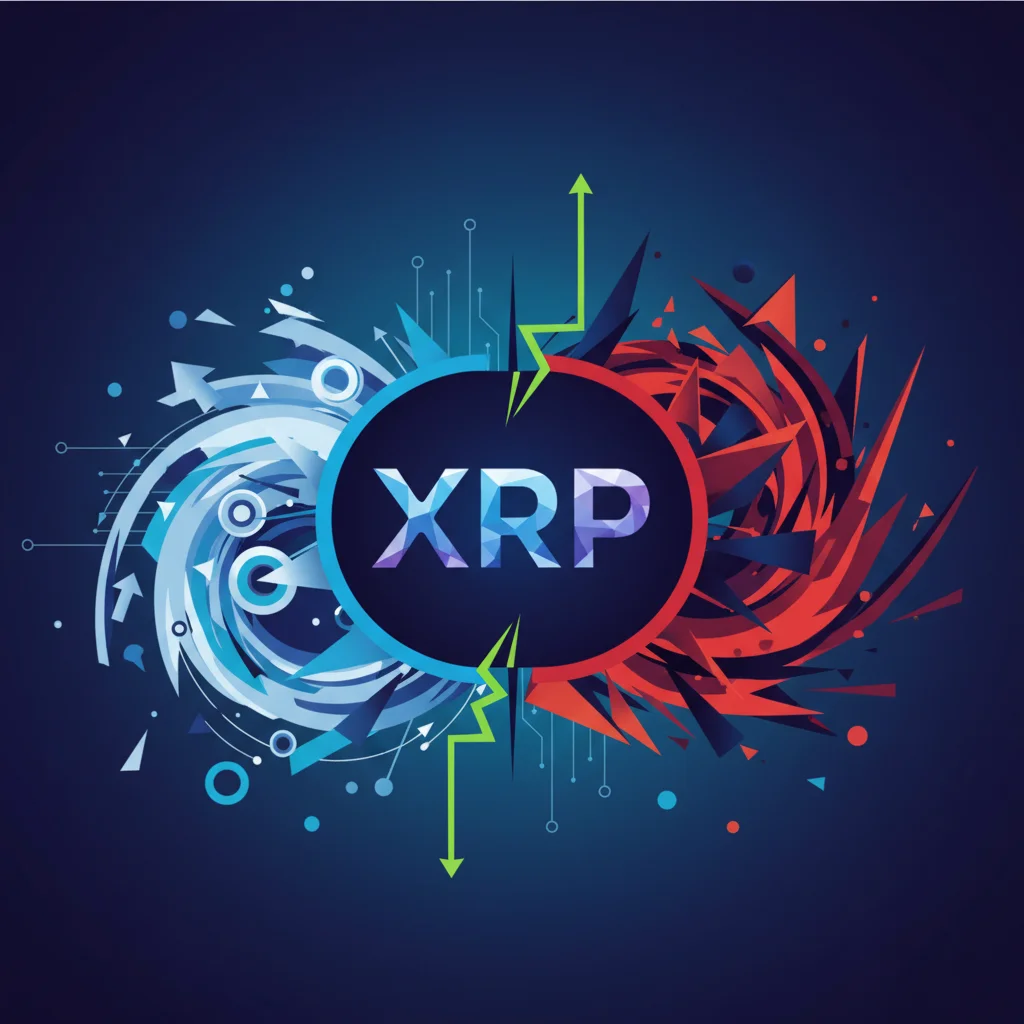
XRP at a Crossroads: Decoding the Pullback as ETF Hype Cools and Bearish Bets Mount
The world of finance and investing is one of constant ebb and flow, a dynamic dance between unbridled optimism and cautious reality. Nowhere is this more apparent than in the volatile realm of digital assets. Recently, XRP, one of the most prominent cryptocurrencies, has been a perfect case study in this phenomenon. After a period of exhilarating gains fueled by speculation, the asset is now facing significant headwinds. The initial euphoria surrounding a potential Exchange-Traded Fund (ETF) is beginning to fade, leading to a wave of profit-taking from early investors.
Simultaneously, a more bearish sentiment is taking hold, with traders building short positions and creating a formidable wall of resistance. This complex interplay of market psychology, technical indicators, and macroeconomic factors has brought XRP to a critical juncture. For investors, finance professionals, and business leaders alike, understanding these dynamics is crucial—not just for assessing XRP’s future, but for grasping the intricate mechanics that drive the modern financial technology (fintech) landscape.
In this deep dive, we will dissect the forces currently shaping XRP’s trajectory. We’ll explore why the ETF excitement has cooled, analyze the technical pressure points that traders are watching, and place these developments within the broader context of the global economy and the evolution of blockchain technology.
The Fading Echo of ETF Euphoria
For years, the “holy grail” for many digital assets has been the approval of a spot ETF in major markets like the United States. An ETF is a type of investment fund traded on stock exchanges, much like a regular stock. A spot crypto ETF would hold the underlying digital asset directly, allowing investors to gain exposure to its price movements through a traditional, regulated brokerage account. This is a game-changer for several reasons:
- Accessibility: It removes the technical barriers of setting up crypto wallets and navigating digital exchanges, opening the door for a wider base of retail investors.
- Institutional Capital: It provides a regulated and familiar vehicle for institutional investors—like pension funds, hedge funds, and endowments—to allocate significant capital to the asset class.
- Legitimacy: Approval from regulators like the SEC lends a powerful stamp of legitimacy, reducing perceived risk and boosting confidence across the financial sector.
The recent market buzz suggested that XRP could be a candidate for its own spot ETF, a rumor that sent a wave of speculative buying through the market. This optimism, however, appears to have been premature. As the initial excitement subsides without a concrete filing or timeline, the market is recalibrating its expectations. This “buy the rumor, sell the news” phenomenon is a classic pattern in both the traditional stock market and the crypto space. When the catalyst for a price surge doesn’t materialize as quickly as hoped, early movers often begin to secure their profits, initiating the first wave of selling pressure.
Technical Headwinds: The Anatomy of a Pullback
As market sentiment shifts from bullish to neutral or bearish, technical analysis becomes paramount. Traders and algorithms begin to focus on key price levels that signal potential turning points. For XRP, the current landscape is defined by profit-taking and the strategic positioning of short-sellers—traders who bet on a price decline.
The core of the issue lies in the overhead resistance. After a strong upward move, an asset often struggles to break through price levels where a large number of investors previously bought or sold. These levels act as psychological barriers. Investors who bought lower see these points as ideal targets to take profits, while those who bought at the peak and are now at a loss may sell as the price returns to their entry point, hoping to break even. This creates a concentrated supply of the asset for sale, which can stall or reverse an upward trend.
According to market analysis, a significant build-up of short positions has been observed below the critical resistance level of $2.57. This indicates that a contingent of traders is actively betting that XRP will fail to break this ceiling and will instead see its price fall. This “short wall” adds to the selling pressure, making it even more difficult for the price to advance.
To better understand the current technical battleground, let’s examine the key support and resistance levels that analysts are closely monitoring. These levels function like floors and ceilings for the price action.
| Level Type | Price Point | Significance |
|---|---|---|
| Major Resistance | $2.57 | A critical ceiling with a high concentration of sellers and short positions. A break above this level could signal a strong bullish continuation. |
| Minor Resistance | $2.40 | An intermediate hurdle that the price must clear before testing the major resistance. |
| Pivot Point | $2.25 | Often seen as the neutral point. Trading above this level is generally considered bullish, while trading below it is bearish. |
| First Support | $2.10 | The first line of defense for buyers. A hold above this level could provide a base for another attempt at breaking resistance. |
| Major Support | $1.95 | A crucial floor. A break below this level could indicate a more significant and prolonged downturn, as it would invalidate the recent bullish structure (source). |
This data illustrates a clear tug-of-war. For XRP to resume its upward trajectory, buyers must absorb the selling pressure from profit-takers and overwhelm the short-sellers concentrated below $2.57. Conversely, if the selling pressure proves too strong and key support levels are breached, it could trigger further declines as stop-loss orders are hit and bearish momentum builds.
The Macroeconomic Backdrop: A Wider Lens on Risk and Capital
No asset, whether in the stock market or the blockchain space, trades in a vacuum. The broader economic environment plays a significant role in investor appetite for risk. In periods of economic uncertainty, high inflation, or rising interest rates, capital tends to flow away from speculative, high-growth assets like fintech stocks and cryptocurrencies and toward safer havens like government bonds and blue-chip equities.
The current decisions of central banks regarding monetary policy are therefore a critical piece of the puzzle. If the global economy shows signs of slowing, or if inflation remains stubbornly high, it could dampen enthusiasm for risk-on investments across the board, including XRP. Investors and corporate treasurers become more selective, prioritizing capital preservation over aggressive growth. This macro pressure can exacerbate the technical selling already present in the market, making it harder for assets like XRP to sustain upward momentum. This is a fundamental principle of modern economics that every serious investor must consider.
Forging the Future: Why AI and Mortgages in UK Schools is a Game-Changer for the Global Economy
Furthermore, the performance of market leaders like Bitcoin and Ethereum often sets the tone for the entire digital asset ecosystem. If these bellwether assets are struggling, it creates a “risk-off” sentiment that tends to pull down other cryptocurrencies, regardless of their individual news or technological developments. Therefore, anyone involved in trading or investing in XRP must also monitor the health of the broader crypto market and its relationship with traditional financial markets.
Actionable Insights for Investors and Business Leaders
Navigating this complex environment requires a strategic, not a reactive, approach. The current situation with XRP offers several key takeaways for different stakeholders in the financial technology landscape.
For Investors:
- Acknowledge the Hype Cycle: Recognize that speculation, especially around events like a potential ETF, can create temporary price bubbles. It is crucial to differentiate between fundamentally driven growth and sentiment-driven rallies. Chasing parabolic moves can be a recipe for disaster.
– Emphasize Risk Management: The build-up of short positions below a key resistance level is a clear warning sign (source). This is a time for prudent risk management, including the use of stop-loss orders and avoiding over-leveraging positions.
– Look Beyond the Ticker: A comprehensive investment thesis should extend beyond short-term price charts. Research the underlying technology, the utility of the XRP Ledger, and the progress of Ripple’s partnerships in the global banking and payments sector. These long-term factors will ultimately be more significant than short-term trading patterns.
For Business and Finance Leaders:
- Understand Volatility in Digital Assets: For companies considering holding digital assets on their balance sheet or integrating blockchain solutions, XRP’s current price action is a potent reminder of the inherent volatility. This must be factored into any corporate treasury or fintech strategy.
- The Future of Financial Technology (Fintech): Regardless of XRP’s price, the underlying technology—fast, low-cost cross-border transactions—continues to address a real-world problem in the banking industry. The push for more efficient financial infrastructure is a powerful secular trend that will continue to drive innovation in blockchain and fintech.
Conclusion: A Market in Search of its Next Catalyst
XRP currently stands at a fascinating and pivotal moment. The initial burst of enthusiasm has given way to the pragmatic realities of market mechanics. Profit-taking, technical resistance, and a growing contingent of bearish traders have created a formidable challenge for the asset in the short term. The path forward will likely be determined by whether a new, powerful catalyst can emerge to shift the narrative and overwhelm the existing selling pressure.
This catalyst could come from a variety of sources: a breakthrough in the regulatory landscape, a major new partnership for Ripple, renewed and concrete progress toward an ETF, or a broad, risk-on rally across all financial markets. Until then, the market remains in a state of delicate equilibrium. For those engaged in trading, finance, and the broader economy, the story of XRP serves as a compelling lesson in the perpetual tension between hype and reality, and a reminder that in the world of investing, staying informed is the ultimate competitive advantage.


